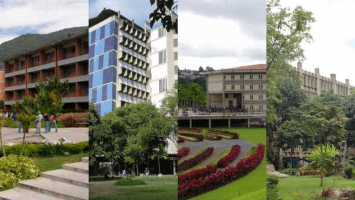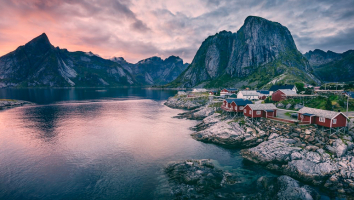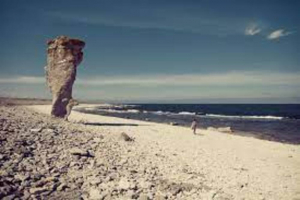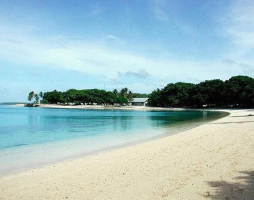Top 14 Best Beaches in Venezuela
Venezuela, located in northern South America, has thousands of kilometers of Caribbean Sea coastline. Thousands of beaches are as diverse as the country's ... read more...natural resources, ranging from well-equipped family beaches to rocky and secluded windsurfer retreats. When compared to other Caribbean resorts, Venezuela beaches are less congested. Toplist presents the Top 14 Most Beautiful Beaches in Venezuela for holidays, vacations, and water sports.
-
Cayo de Agua is part of the Los Roques archipelago, which is located in the southern Caribbean Sea, about 100 kilometers north of Venezuela's capital, Caracas, and the same distance east of Curacao. This area of the water is one of the most advantageous in the entire sea. There are only a handful well-known storms. And the amount of clear sunny days is among the highest in the world.
From the outside, the Island may appear unfit for living and relaxing. It is almost entirely made up of sands that have become entangled in bizarre shapes in shallow water. There are some rises—about 10 meters above sea level—in several spots. The hills are also made up of sand dunes and are covered in sparse flora, mostly grass.
The island's sand has two distinct hues and compositions. The majority of the land is covered in microscopic white sands derived mostly from sedimentary rocks and coral reef remnants. A trail of red sands with larger grains of sand predominates closer to the eastern extremity. The sea, which is extremely shallow near the coast, is seeded with sand.
The island is part of a tiny archipelago. Large currents and mixing of water, as well as the inflow of cold masses, are prevented by neighboring islands. As a result, the water warms to a temperature of 26 28 degrees Fahrenheit and remains there for virtually the whole year. This year's most unfavorable month is January. Even at this time of year, water rarely gets colder than 25 degrees.Cayo de Agua is located in the eastern Caribbean Sea that is part of the Los Roques Archipelago and is administered as part of the Federal Dependencies, Venezuela.

Photo: Wikipedia Video: 1001beach's Youtube Channel -
Choroni is a small village on Venezuela's northern coast, roughly midway between Valencia and Caracas, west of the country's capital. The city does not greatly differ from the other settlements in Latin America, it is a standard small resort with classical Creole architecture, which is diluted with frequent hotels and small restaurants with an unusually high concentration of pizzerias.
The city's beach is known as Playa Grande (literally the Great Beach). It's roughly a half-kilometer east of Choroni. The beach is stuck between a mountain that juts out into the sea from the north and a slew of more moderate hills from the east (here is the reserve Henri-Pete). The beach is directly open to the Caribbean Sea and is washed by its waters. The beach is accessible via the mountain on the north side. There are other little paths that travel through the forest in every other direction. It is better to walk along the main route, especially since it begins from The Tourist Center in the city.
The major stretch of the beach is about a kilometer and a half long. It is rather small—only 40-50 meters long—and made of light sand. Green palms carefully planted for the "kind of bounty" reach almost close to the coastline in some areas.
The sand on the beach is tiny and light golden in color, with a little filthy appearance. There are some beautiful stones closer to the boundaries on the north and east sides. Walking by the lake there, on the other hand, becomes a little uncomfortable.
The beach is cleaned on a regular basis, but not as thoroughly as many tourists staying in five-star hotels are accustomed to. There is no ash bin visible. As a result, you will need to bring as much waste as possible with you in order to dispose of it in a container along the road in front of the city.Choroní is a popular place located in Aragua, Venezuela.
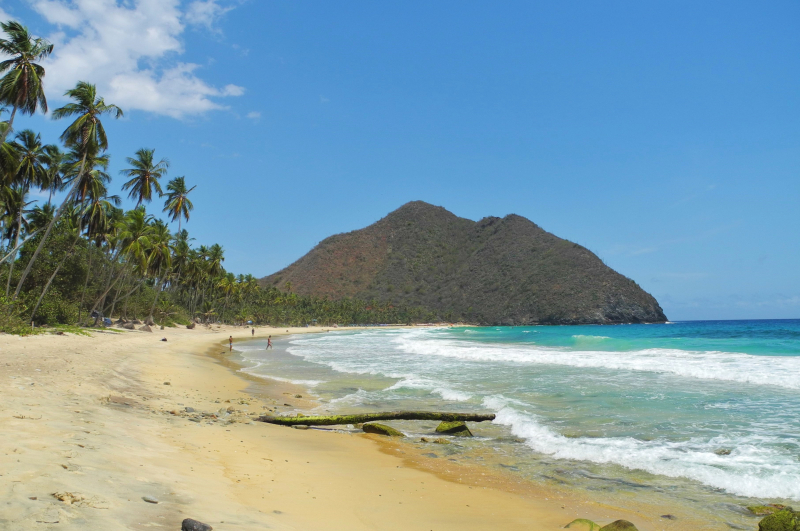
Photo: Wikimedia Commons Video: 1001beach's Youtube Channel -
El Yaque Beach is located in the southern section of Venezuela's gem, Margarita island, staring directly to the continent. The beach is wedged between two mountain ranges, and its lengthy sands connect them. The sea waters cut deep enough into the coast near the beach to make a natural shallow lagoon with a sandy bottom.
As the island of Margarita is regarded as the best spot in Venezuela for tourist and residence, El Yake is clearly the leader in the section of a lazy beach and active rest immediately on the island. The beach is defined by a long, ragged edge of white sand that spans about fifty meters in some areas.
Because there are few plants, coral, or stone clusters on the bottom of the coastal waters, the sea appears monotonous azure. During the tides, the water can rise rather strongly due to the caverns of the slope into the bay (shallow water reaches in some spots approximately 150 meters). The sea, on the other hand, is marked by the absence of rubbish, and therefore the shore, even after the tide, is distinguished by cleanliness. Furthermore, the beach in the hotel area is cleaned, and in many civilized locations near the ocean, there are enormous closed urns to prevent unpleasant odors in the tropical heat.
Because the island is not volcanic in nature, the waters surrounding it are quite small; huge vessels are not permitted to navigate the strait due to the fluctuating fairway. At the same time, wind is constantly blowing from the east or west, depending on the season. This creates great conditions for the sports of windsurfing and kitesurfing. El Yake is regarded as a cult destination among those seeking an active vacation.El Yaque Beach is located in the south side of Island of Margarita, Venezuela.

Photo: TripAdvisor Video: Rubenfelaphoto Photo&Video's Youtube Channel -
La Tortuga Island, or the Turtle Island, has a rich history, but it is also incredibly remote - Tortuga is over 120 kilometers from Margarita Island. You can arrive at the beach by chartering a private plane or yacht.
The island's distance may be viewed in two ways. On the one hand, it is increasingly attracting tourists who want to relax in a peaceful location. On the other hand, this arrangement plays into the hands of the native flora, which has been nearly entirely untouched until now.Fishing and diving are the major forms of entertainment on the island. There are many underwater dwellers, including crawfish, Dorado, and perch, as well as gorgeous reefs. Furthermore, La Tortuga Island is a true paradise for those who like peaceful and solitary relaxation, with the option of pampering under the sun and strolling along the snow-white sandy shore along the blue glass. However, such a paradise will have to be reserved in advance due to the island's limited capacity. You can also go on an incredible, yet brief, excursion to the island aboard a yacht that sails from the city of Igor, which is just a few hundred meters from Caracas.
La Tortuga Island is located off the southeastern coast of the Nicoya Peninsula and is 120 kilometers away from Margarita Island.

Photo: Costa Cat Cruises Video: Infinity Visuals's Youtube Channel -
Cayo Sombrero Beach is one of Venezuela's greatest, thus the island of the same name is fairly crowded, despite its rocky-sandy coast. In the northwestern area of Venezuela, there is a magnificent beach in a national park called Morrocoy (Falcon State).
To get to the coast by boat, you can sail from Chichirvichi, where buses go from the Caracas airport, or from Tukakas, however the latter will take a little longer. The temperature of water and air remains nearly constant throughout the year, with only a few degrees variance. Strong gusts, however, warn holidaymakers against relaxing on the beach from mid-February until March.
The beach area is quite large and diversified, ranging from a lake with a coast to palm thickets. Along the beach's shoreline, there is also chair lounge rental, camping, and eateries. In addition, you can dive into the blue water to see coral and unusual fish species. After all, it's a fantastic spot for divers and lovers of unique nature—mangrove forests, pelicans and flamingos, reptiles and turtles. The incredible universe of Venezuelan fauna is open here, in the palm of your hand.
Cayo Sombrero is an island located in Chichiriviche in the Falcon State in Venezuela.

Photo: Cayo Sombrero Beach (Photo: Twitter) Video: Lucho Narvaez's Youtube Channel -
Playa Medina Beach is regarded as one of the Caribbean's most beautiful. It is situated in a former coconut farm in northern Sucre, about an hour's drive from Rio Caribe. The beach is accessible by automobile or cab. During the season, it is extremely crowded, especially on weekends when residents flock there.
The Medina Beach consists of excellent golden sand, clear azure sea, attractive boulders, and lush tropical vegetation. It is great for a relaxing beach vacation with children, a couple, or a group. Palm trees, which grow densely along the shore, reach all the way to the water here. The descent into the sea is mild, the bottom is sandy, and the water is calm and transparent, making it ideal for swimming, snorkeling, and boating. Visitors who are hungry can eat at local cafés and stay overnight directly on the beach to witness a spectacular tropical sunset. There are various bungalows that must be reserved ahead of time.
Tourists on a holiday at Medina Beach can also visit the nearby beach, Playa Puy, which is only 20 minutes away, and a chocolate factory on the route to the Rio Caribbean.It is situated in northern Sucre, Venezuela.

Photo: Franks Travelbox Video: Thore Noernberg's Youtube Channel -
Playa Puerto Cruz is a 1 kilometer long sandy beach on Margarita Island near Pedro Gonzalez. There are ferry connections from Cumana and Puerto La Cruz, as well as a ship from Caracas.
During the low season, the beach is not overcrowded, so anyone seeking privacy as well as a calm, quiet location for barbeque devices will find it at Playa Puerto Cruz. It is recommended that you bring food, chair lounges, and umbrellas with you for the entire day. During the peak season, the rooms are fairly congested, thus rooms in surrounding hotels should be reserved ahead of time.
Despite the fact that Playa Puerto Cruz is located in a windswept harbor, there are occasionally big waves and frigid water. Beachgoers can surf, windsurf, sail, boat, boat, and boat trips, as well as walk to the lighthouse, which is located in the northern portion of the beach.
Venezuela was fortunate in its geographical location: storms and tornadoes practically never travel through its territory, and the subequatorial climate ensures that temperatures do not fall below 20 degrees and do not soar over 27 degrees all year. During the dry season, from November to May, is the best time to visit Venezuela.Playa Puerto Cruz is located near Pedro Gonzalez in Isla Margarita, Venezuela.

Photo: Wikimedia Commons Video: Nora Urbano's Youtube Channel -
Bahia de Cata is a huge sandy beach near Mariara and El Limon in Cata town, Aragua state. It takes 40-60 minutes to drive there from Maracay, the state capital. Bahia de Carta is encircled on all sides by a coconut grove. The sea near the coast is shallow and frequently has gentle waves. The beach is popular with locals who come here with their children, thus it can get busy at times.
The coast of Baia de Kata is provided with cafes, resting shelters, and sun umbrellas for the comfort of guests. Aside from sunbathing and swimming, visitors can take a boat to the nearby beach of Catica, ski, and snorkel. There are various motels along the beach where you can spend the night. The nearest attraction to the beach is Henri Pittier, Venezuela's oldest national park. During the dry season, from November to May, is the best time to visit Venezuela.
Bahía de Cata is a beach of Aragua state, Venezuela.
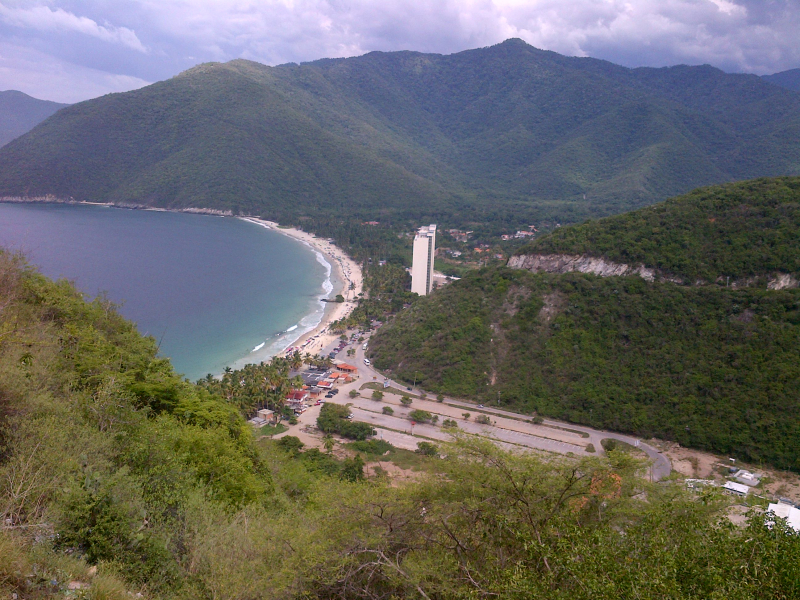
Photo: Wikimedia Commons Video: DroneroVideos's Youtube Channel -
Punta Arenas Beach is located on the Macanao Peninsula, and it takes around an hour to reach there by bus or cab from Porlamar. Traditionally, the beach is divided into two sections: one where you can catch modest waves, and the other where you may find little restaurants. There are larger waves in the second section of the beach, but lovers of the sandy shore will find a space for themselves in any area of the beach, as there is minimal vegetation and sun loungers can be rented throughout the island.
The cleanest water, the variety of shellfish, and the attractiveness of the beach draw visitors all year, with the added benefit that the water temperature rarely falls below 26 degrees. Rest will help to diversify the beach: local food; national holidays (the island is rumored to be unusually crowded these days); diving to sea stars and fishing
If you have the chance to visit adjacent islands, it is worth it to go horseback riding on Makanovo or swimming with dolphins in the village of Pampatar, which is very significant for family vacations. In the Diverland amusement park, you can also witness monkeys, amusing tukans, unusual parrots, and fur seals.Punta Arenas Beach is located in Nueva Esparta, Venezuela.
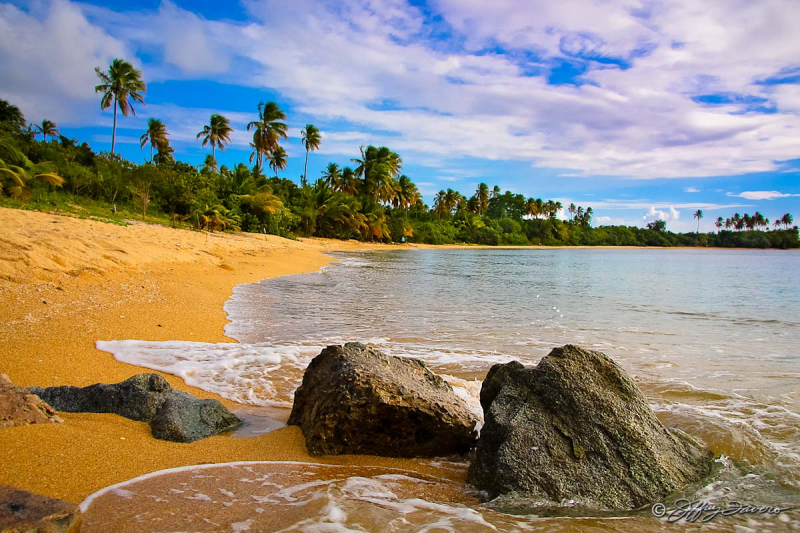
Photo: https://jeffreyfavero.com/ Video: Around the World's Youtube Channel -
Cayo Playuelita beach is a small island beach in the Morrocoy marine park near Tucacas. Natural circumstances and a lack of apparent seasonality contribute to a fantastic beach vacation and snorkeling here all year. Cayo Playuelita offers a pristine sandy beach lined with palm trees, a tranquil sea with a shallow part, and a reef teeming with colorful fish.
Only a boat ride is an option. In order to get to the beach. Because there are no hotels on this island, it is best to worry about the night by booking a room in a hotel or guest house on the mainland, such as Tukakas or Chichiriviche. In comparison to other coastal areas in Venezuela, housing prices are extremely high.
There includes beach umbrella and diving equipment rental, a shower, toilet, change facilities, cafes and shops selling souvenirs, food, and drinks. Visitors to the beach can swim and sunbathe, dive, and take boat cruises around adjacent islands.
Cayo Playuelita Beach is located in Falcón, Venezuela.

Photo: Mapio.net Video: Braian Soto's Youtube Channel -
Playa Punta Brava is located within the Morrocoy National Park. It is the only beach in the area with a bridge connecting it to the mainland. The most convenient way to reach there is from Tucacas, either by walking or driving. A fee is required at the beach's entrance.
Playa Punta Brava is a sandy, shallow beach with clear, warm water and gentle waves. Visitors to the beach can swim, sunbathe, and dive with a mask and snorkel. There is parking on the beach's property, as well as everything you need for a relaxing beach day - a restaurant, changing rooms, toilets, and the rental of beach umbrellas and sun loungers. Because all hotels are on the mainland, beachgoers will have to return to Tukakas in the evening.
Venezuela was fortunate in its geographical location: storms and tornadoes practically never travel through its territory, and the subequatorial climate ensures that temperatures do not fall below 20 degrees and do not soar over 27 degrees all year. During the dry season, from November to May, is the best time to visit Venezuela.
Punta Brava Beach is located in Falcón, Venezuela.
Photo: Keithpp's Blog - WordPress.com Video: ELLISON BOLIVAR's Youtube Channel -
Cayo Muerto Beach is on a small island near the resort town of Chichiriviche that is part of the Morrocoy National Marine Park. Beautiful scenery and crystal clear, quiet water draw a lot of visitors, especially during the busy season, which runs from December to March.
To get to the beach, take a bus or rent a car from Caracas to Chichiriviche. Because there are no hotels on Kao-Muerto, the hotel can be removed here and then, after hiring a boat, you can access the beach in a few minutes.
The Kaio-Muerto Coast, with its many palm palms and mangroves, appears to be very lovely. The beach itself is a sandy shell with coral crumbs inserted, with a gentle fall to the water. Coastal waters are typically tranquil, making them ideal for regular beach vacations as well as snorkeling, diving, and kayaking. There are cafes on the beach where you can get a snack, toilets, changing cabins, and rent beach equipment. Snorkeling enthusiasts are surrounded by coral reefs and exotic tropical creatures.
Cayo Muerto Beach is located in Falcón, Venezuela.

Photo: Mapcarta Video: Josue Torres's Youtube Channel -
Cayo Playa Mero Island, which is part of Morrocoy National Park, is home to Playa Mero Beach. It is accessible by boat from Tukakase. The visitor can snorkel, swim, and sunbathe while relaxing on the beach.
Mero is ranked among Venezuela's top 10 beaches with good reason. Visitors are surrounded by beautiful mangrove forests and groves of coconut palms, fine white sand, and a clear, tranquil water with a relatively big shallow and sandy bottom. This beach is hardly frequented by loud companies, so anyone seeking privacy will enjoy it.
You can hire umbrellas and sunbeds, as well as eateries where you may eat a snack, for a relaxing beach vacation. There are no hotels on the island, so tourists must return to the mainland and get a night at one of the Tukakas hotels. During the dry season, from November to May, is the best time to visit Venezuela.
Mero Beach is located in Falcón, Venezuela.

Photo: TripAdvisor Video: Paul Jasion's Youtube Channel -
Cayo Boca Seca Beach is one of the greatest in the Tucacas area (Morrocoy National Park), which is located on an island off the coast of northern Venezuela. It is quite popular with tourists, so it is frequently congested during the peak season (in the winter months). Cayo Boca Seca beach is only accessible by boat, which may be rented at Tucacas.
Except for hotels, the beach contains everything you need for a beach vacation. The hotel provides a variety of amenities such as parasols and other beach accessories, snorkeling equipment, and a restaurant. After a relaxing day, holidaymakers must return to the mainland in the evening, as night camping on the Cayo Boca Seca beach is prohibited. The hotel is most conveniently positioned in the nearby towns of Tukakas and Chichiriviche.
Kao Boca Seka is well-known for being a wonderful area for families to unwind. Beautiful scenery, tranquil shallow water, stable warm water (t° 27-29°C), and a clean shore with a sandy-stony covering all help.Cayo Boca Seca Beach is located in Falcón, Venezuela.

Photo: Flickr.com Video:Tuberia Industrial's Youtube Channel
















